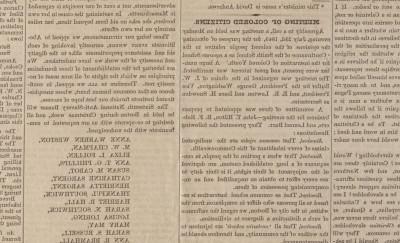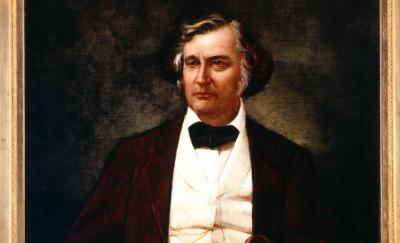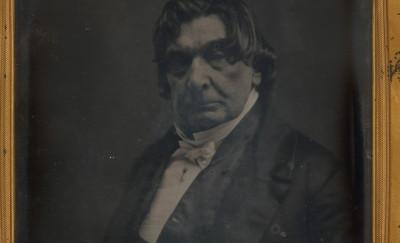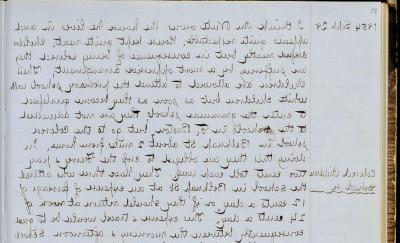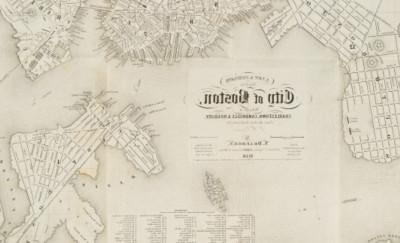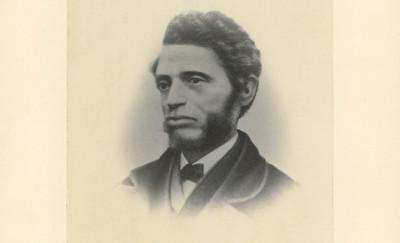"A Great Public Nuisance": Boston's segregated schools in the mid-1800s
Inquiry Question 1: Prior to 1855, in what ways did segregated schools harm Black children in Boston?
Inquiry Question 2: What actions did Black families take to advocate for integration?
Source Set
Download Source Set
Glossary
Transcript: a typed copy of a written document
Segregation: the separation of people because of their race, or skin color
Integration: to bring together people of different races (e.g., into the same school)
Exclusive: limited in access
Caste: the idea that your place in society is inherited at birth, and cannot be changed
Analyzing Primary Sources
As you read the sources ask yourself:
Who created this primary source?
- What do you know about the creator(s)?
When was it created?
Does it support segregated or integrated schools?
What claims does it make to support its argument?
Black Bostonians built the African Meeting House in 1806 and it is the oldest Black church building in the United States. The African Meeting House also housed a school for Black children until the Abiel Smith school, named for its wealthy white benefactor, was built on the same block in 1835.
In the early-mid 1800s, the African Meeting House was also known as the “Belknap Street Church” and the Smith School as the “Belknap Street School”. In Document 5, Luman Boyden refers to the Abiel Smith school as the “school in Belknap St.” The article in The Liberator (Document 2) refers to it as the “Smith School.”
Belknap Street was later renamed Joy Street. Today, the Smith School and the African Meeting House are properties of the Museum of African American History, located at 46 Joy Street, and are stops on Boston’s Black Heritage Trail.
Citation: African Meeting House, Photograph, circa 1892, From William Lloyd Garrison, 1805-1879: The Story of His Life, Volume I, Part II, by Wendell Phillips Garrison, (NY, 1885), extra illustrated edition, image opposite page 280, Massachusetts Historical Society, http://twod.ngskmc-eis.net/database/1684.
In this article, published in the antislavery newspaper The Liberator, Black Bostonians argue for the Smith school to be closed and for all public schools in the city to be integrated. The citizens, including Benjamin Roberts, who had already filed a lawsuit on behalf of his five-year-old daughter, Sarah, appealed directly to Boston’s mayor.
This article appears on the right-hand side of image 3 of this edition of the Liberator.
Citation: Garrison, William Lloyd, and James Brown Yerrinton, The Liberator. Boston, Mass.: William Lloyd Garrison and Isaac Knapp, August 10, 1849, Boston Public Library, http://ark.digitalcommonwealth.org/ark:/50959/5h741r031.
Read an excerpt of Morris and Sumner's argument in Sarah C. Roberts v. City of Boston.
I begin with the principle, that, according to the spirit of American institutions, and especially of the Constitution of Massachusetts, all men, without distinction of color or race, are equal before the law...
In 1849, Charles Sumner (1811-1874), a white abolitionist and lawyer, acted as co-counsel with Robert Morris, a Black abolitionist and lawyer, to challenge the segregation of Boston’s public schools. Sumner and Morris argued their case, Sarah C. Roberts vs. The City of Boston, in front of the Supreme Court of Massachusetts.
Although they lost, in 1855, the Massachusetts legislature banned segregated public schools in the state. Their arguments in this case also influenced the arguments made in front of the United States Supreme Court in the Brown v. Board of Education (1954) case that made segregation in public schools illegal throughout the country.
In 1851, Sumner was elected to the United States Senate where he served until 1874.
You can read the Argument of Charles Sumner, esq., against the constitutionality of separate colored schools : in the case of Sarah C. Roberts vs. The City of Boston. Before the Supreme Court of Mass., Dec. 4, 1849, in full here.
Citation: Charles Sumner. Portrait, oil on canvas by Darius Cobb, 1877, Massachusetts Historical Society, http://twod.ngskmc-eis.net/database/1634.
Read an excerpt of Chief Justice Shaw's opinion in Sarah C. Roberts v. the City of Boston.
…It is urged, that this maintenance of separate schools tends to deepen and perpetuate the odious distinction of caste, founded in a deep-rooted prejudice in public opinion. This prejudice, if it exists, is not created by law, and probably cannot be changed by law…
Lemuel Shaw was chief justice of the Massachusetts Supreme Judicial Court from 1830-1860. In 1849, Shaw upheld the segregation of Boston’s public schools in Sarah C. Roberts vs. the City of Boston. Roberts lost her case. In 1896, the United States Supreme Court echoed many of Shaw's arguments when it upheld segregation in the case Plessy v. Ferguson.
This image is a daguerreotype, which was an early type of photograph popular in the 1840s and 1850s.
Read a transcript of Shaw’s full opinion, quoted in the gray box, here (scroll down to “Opinion”).
Citation: Lemuel Shaw, Daguerreotype by Southworth & Hawes, circa 1853, From the Daguerreotype collection, Massachusetts Historical Society, http://twod.ngskmc-eis.net/database/454.
... in consequence of being colored they are suffering by a most oppressive arrangement. Their children are allowed to attend the primary schools with white children but as soon as they become qualified to enter the grammar school, they are not admitted to the schools in E. Boston but go to the colored school in Belknap St. about 2 miles from home.
Luman Boyden (1805-1876) was a reverend who worked as a missionary in East Boston, Massachusetts during the 1850s and 1860s. For his job, he visited and assisted families in the neighborhood. He wrote about his work in his diary. His entries show evidence of both empathy for and judgment of the people in the neighborhood.
Up until 1855, Boston's public schools were segregated. A school for Black children was located on Belknap St., far from East Boston. In this excerpt from September 28, 1854, Boyden describes meeting the Nutts, a Black family, and the difficulties segregated schools forced on them.
In his journal, Boyden misspells their last name as "Nute," which might be a clue as to how to pronounce their surname! Learn more about the Nutt family in the 1850 US Census and the 1855 MA People of Color census.
Citation: Luman Boyden Missionary Journals, 1854-1863 Vol. 1, Diary, 1854-1855, Image 24, Massachusetts Historical Society, http://twod.ngskmc-eis.net/collection-guides/digitized/fa0538.
In this 1846 map of Boston, East Boston is located in the lower right hand side. The East Boston ferry traveled between East Boston wharf and Lewis’ wharf to connect East Boston to the rest of the city.
Zoom in on the map to find: Belknap St. (where the Smith School was located) and the East Boston ferry that the Nute children took to and from school. What route might they have taken from the ferry wharf to the school?
Citation: A new & complete map of the City of Boston: with part of Charlestown, Cambridge and Roxbury, From the best authorities by G.W. Boynton, for N. Dearborn, Nathaniel Dearborn, 1846, Massachusetts Historical Society, http://twod.ngskmc-eis.net/database/3441.
…to the women, and the children also, is the cause especially indebted for success… It was the mothers (God bless them!) of these little bright-eyed boys and girls, who, through every step of our progress, were executive and vigilant, even to that memorable Monday morning, (Sept. 3, 1855), the trial hour, when the colored children of Boston went up to occupy the long-promised land. It was these mothers who accompanied me to the various school-houses, to residences of teachers and committee-men, to see the laws of the Old Bay State applied in good faith.
Address of William C. Nell, Boston December 17, 1855
On September 3, 1855, Boston Public Schools officially began to integrate. On December 17, 1855, Black citizens of Boston met at Southac Street Church to celebrate and, in particular, to honor William C. Nell for his leadership on behalf of integration. Nell, also a leading Black abolitionist, had been a student at the segregated Smith School as a child and had felt the pain of being denied the same educational opportunities as his white peers.
At the event on December 17th, many people gave speeches, and they presented Nell with a gold watch. The watch was transcribed, "A tribute to William C. Nell, from the colored citizens of Boston, for his untiring efforts in behalf of equal school rights, Dec. 17, 1855." Nell also made an address to mark the occasion, part of which is quoted in the gray box to the left.
Photograph Citation: William C. Nell, from Portraits of American Abolitionists (a collection of images of individuals representing a broad spectrum of viewpoints in the slavery debate), Massachusetts Historical Society, twod.ngskmc-eis.net/database/1338.
Quotation Citation: "Triumph of equal schools rights in Boston: proceedings of the presentation meeting held in Boston, Dec. 17, 1855: including addresses by John T. Hilton, Wm. C. Nell, Charles W. Slack, Wendell Phillips, Wm. Lloyd Garrison, Charles Lenox Remond," Boston, R.F. Wallcut: 1856, Massachusetts Historical Society.
For Teachers
"A Great Public Nuisance": Boston's segregated schools in the mid-1800s
Background Reading
- Historical Overview: Boston's segregated schools in the mid-1800s
-
“A Great Public Nuisance”: Segregated schools in 19th-century Boston
What is a public school? What is its purpose?
A public school is a free, tax-funded school that is controlled by local government. By 1849, Boston’s public school district was the only remaining segregated school district in Massachusetts. The General School Committee was in charge of Boston’s public schools. While the school committee directed white children to attend the school nearest their home, there were only two schools for Black children (the Smith School, on Belknap St. and a school on Sun Court). Thus, many Black children had long commutes that their white peers did not have.
Children between the ages of four and seven attended primary schools, where they learned reading, writing, spelling, math and ‘decent behaviour.’ Children eight and older could attend grammar schools, which taught Greek, Latin and English languages. During this time, schools did not provide transportation or lunches for students. The school day was divided into a morning and afternoon session, and students ate lunch outside of school.
By the 1830s, many advocates for public schools argued that education prepared people for citizenship. Specifically, they argued that education was necessary for men to be informed voters, for women to raise their children well, and for immigrants to become Americanized.
While public schools opened their doors to white immigrants, Black Bostonian remained shut out. This became a source of frustration for Black families, who wanted public schools and the benefits of citizenship to be accessible to everyone. In 1830, 5% of Bostonians had been born in a different country. Ireland’s potato famine was one of the leading causes of immigration to Boston. Tens of thousands of Irish people fled their homeland during the 1840s, where they didn’t have enough food, and sailed to Boston. By 1855, the year Boston finally integrated its schools, more than half of its population had been born outside of the United States.
History of schools for Boston’s Black community
In 1788, Prince Hall, a leading member of Boston’s Black community, opened a school for Black children in his home. In 1808, the school moved into the African Meeting House, a church built in 1806, on Belknap St. Boston had refused to spend public money to provide a school for Black children, so Black families funded, staffed, and ran the school themselves. One of the school’s first teachers was John Russwurm, the founder of the antislavery newspaper Freedom’s Journal. Many Black families lived near Belknap Street, which quickly became the center of Boston’s Black community. There, families gathered, worshipped, learned, and worked for causes like abolition (in the South) and integration (in Boston) together.
The Smith School
In 1815, Abiel Smith, a wealthy white man, gave the Belknap Street School a large donation. For this reason, the school was renamed the ‘Smith School.’ The Boston School Committee took over the Smith School in 1816, and it became part of Boston’s public schools (but it remained a school for Black children only). The school committee fired Black teachers and hired white ones instead. Many Black families began to complain about the changes they saw in the school. The school also fell into poor condition. In 1835, the Smith School moved into a new building—right next to its previous location in the basement of the African Meeting House, but families remained angry.
In 1844, Black families began petitioning the school committee to desegregate Boston’s schools. Many families chose to boycott the Smith School as a form of protest. In 1849, Benjamin Roberts, a printer and abolitionist, sued the city of Boston on behalf of his five-year-old daughter, Sarah C. Roberts, who passed five other schools on her daily walk to the Smith School. Roberts wanted Boston to integrate its primary schools and include all children. Roberts’ lawyers, Robert Morris and Charles Sumner, argued that segregated schools violated the principle—included in the Massachusetts Constitution—of equality before the law. They also argued that all children benefited from learning together. They lost their case, but six years later, in 1855, the Massachusetts Legislature wrote a law banning segregated schools.
In this primary source set, students read about specific hardships segregated schools presented Black families, and the ways in which they worked for integration.
Source:
Moss, Hilary, “Section III. Education’s Divide: Boston, Massachusetts,” Schooling Citizens: The Struggle for African American Education in Antebellum America (2009)
For further reading:
“The Sarah Roberts Case,” Smith Court Stories, The Sarah Roberts Case | Smith Court Stories (Museum of African American History and the National Park Service)
“The Struggle for Equal Education,” Smith Court Stories, The Struggle for Equal Education | Smith Court Stories (Museum of African American History and the National Park Service)
“Student Life,” Smith Court Stories, Student Life | Smith Court Stories (Museum of African American History and the National Park Service)
Close Reading Questions
Throughout these primary source documents, students will likely notice the use of the word “colored” instead of “Black.” This is an opportunity to discuss some important points about Black Americans during this time. It will be necessary to give context to that term and remind students it is not a word used in our vernacular today. And impress upon them the power that words hold and that some terms should not be used today.
- Questions to ask for each document
-
Photograph of Boston’s African Meeting House
- In what ways might a community (in this case Boston’s Black community) benefit from building and maintaining its own institutions (such as churches and schools)?
- What would be the benefits to living close to the meeting house and Smith school?
“Meeting of Colored Citizens,” The Liberator
Transcript here. Students can also read this article with simplified, modern language here.
- According to the authors, in what ways do segregated schools harm Black and white children?
- What solution do they want to see?
- Why do you think they use the word “citizens” to describe themselves in the headline and throughout the article?
- What do they argue the government owes them as citizens?
- The Liberator was an antislavery newspaper published in Boston. Why might the authors have chosen to publish their appeal there?
Charles Sumner, Sarah C. Roberts v. City of Boston
Sumner and Morris’s full argument in Sarah C. Roberts v. City of Boston is long. These questions are geared toward this transcribed excerpt, where Sumner and Morris talk about Roberts, and why this case violates the principle in the MA Constitution of equality before the law.
- What are the practical harms of segregation does Sumner write about?
- What are the moral harms?
- Why does Sumner make reference to the patriots of the American Revolution and their objection to a 'paltry tax on tea'?
- Like Sumner, Black citizens in the Liberator article also talk about their ancestors' contributions and the long history of public schools in New England -- Why?
Lemuel Shaw excerpt, Sarah C. Roberts v. City of Boston
- What argument is Shaw making about separate schools?
- What claims does Shaw make to support his argument?
- What is his vision for society?
Luman Boyden diary
Questions for shortened text (more for grades 3-5; 6-8):
- What specific harms did segregated schools mean for the Nute/Nutt children?
- What do you think the family wanted for their children?
Questions for full transcription (grades 9-12):
- What specific harms do segregated schools present for the Nute children?
- What does the family want for their children?
- What actions have they taken to try and achieve their goal?
Discuss with students the class biases apparent in Boyden’s diary entry.
- What words does he use to describe the Nute family? Why might this be important to him?
- Do you think he would be “resolved to plead their cause” if they were not “quite respectable” and “neat”?
- What words does Boyden use to describe white children in East Boston’s public schools? Who might these children be? What might “dirtiest, vilest” be code for?
- What do these descriptions tell us about Boyden [and, perhaps, other middle-class white Americans of the time]?
Analyzing the 1850 US Federal Census transcription records to learn more about the Nutt family and their neighbors may help students unpack these questions.
Suggested Activities
- Comparing accounts of Sarah C. Roberts and the Nutt family children (Grades 3-5; 6-8)
-
Materials:
-
Violation of Equality Before the Law, an excerpt from Sumner and Morris’s argument in Sarah C. Roberts vs. the City of Boston (1849)
-
the shortened and simplified version of Luman Boyden’s diary entry (1854) on the Nutt family.
Ask:
-
How were Sarah Roberts' and the Nutt children stories similar?
-
In what ways were they different?
-
What might be the reasons for each?
Students may notice. . .
Similarities
-
Distance: Both were excluded from the schools nearest their homes
-
Both had parents fighting for integration (Sarah’s father sued the city; the Nutt family appealed to the School committee and asked Boyden for his help)
Differences
-
Roberts was excluded from a primary school; the Nutt children attended primary schools with white children, but were later excluded from the grammar schools
-
Roberts could walk to the Smith School on Belknap St.; the Nutt children had to walk and take a ferry, which cost money
-
If Roberts had won, her case would have integrated schools for all children; the Nutt family’s actions, if successful, would have had a smaller impact
-
- Analyzing claims and arguments (Grades 9-12)
-
Materials: Document Analysis Worksheets
To whom should access to public schools belong? What rights do citizens have?
The article in The Liberator, the lawsuit Sarah C. Roberts v. the City of Boston, and Boyden’s full diary entry all give examples of the harms of segregation and actions Black families took in opposition to segregation. Each also puts forth a vision of citizenship. In this activity, students analyze quotes from these documents to analyze their claims, and uncover what Black families in Boston wanted for their children.
Have students work alone or with partners to complete the worksheet. Then, discuss as a class:
-
What specific harms did segregation create? What actions did Black families take to oppose segregation?
-
What is the role of public schools in preparing people for citizenship?
-
What responsibilities does a government have to its citizens?
-
- Drawing Inferences: Digging into the Census Records
-
Materials: 1850 US Federal census transcription and 1855 MA POC census transcription
We can learn more about the family Boyden writes about in his diary by looking at state and federal census records, and Boston’s city directory records from the 1850s. (Note on research: Boyden records the family’s name as “Nute,” but there is no Black family of that name in either of these censuses. There is, however, a “Nutt” family with three school-aged children who live in East Boston.)
Note on language: In the 1850s, censuses and other official records used “white,” black,” and “mulatto” as racial categories. In the 1850 census transcription, we have used “mixed race” in place of “mulatto,” which is an offensive word and not acceptable to use today. You may want to have a conversation with students about this term, and also about the idea that many people in the 1850s may not have identified as any of the above terms.
-
These are the categories the government used. What problems might there have been with these categories?
Have students take time to examine the transcriptions of the Nutt family and their neighbors in the US 1850 Federal Census and of the Nutt family in the 1855 MA People of Color State Census. Ask:
-
What can you learn about the Nutt family in each?
-
Are there any inconsistencies (possible errors) between the two censuses?
-
Shadrack Nutt’s age is the same in both censuses, even though taken 5 years apart
-
-
What can you learn about the people who lived in the family’s neighborhood?
-
What limitations does a census have? (What can’t we learn from a census? What issues could there be with accuracy?)
-
Note which children have attended school in the past year.
-
What children were not in school? Why might they not have been attending school?
-
With which neighbors might the Nutt children have been classmates? From which neighbors would they have been separated?
-
For students who read the full Boyden document, ask:
-
What can the census records tell us about Luman Boyden’s diary entry – what do you think made him see the Nutt family as “respectable”?
-
Which white neighbors might he have described as “dirty, vile”?
-
What does this tell us about Boyden's biases [and, perhaps, the biases of middle-class white Americans at this time]?
-
-
- Making Connections: Mapping School Routes – Then and Now
-
Materials: 1846 map of Boston
Points of interest on the map -- Teacher Key (GoogleSlide)
Have students look at the map to identify the following locations:
-
The intersection of Saratoga and Prescott Streets (where the Nutt family lived in 1854)
-
“East Boston wf [wharf]” and East Boston ferry route
-
Belknap Street (site of the Smith School)
-
Any public schools labeled on the map (Hint: there’s one in East Boston)
Have students map out a route for the Nutt children to get to and from school each day.
-
Where might they have gone outdoors to spend their lunchtime?
Have students draw a map of their route to school.
- What will you include: Local buildings or landmarks? Street names? Mode of transportation?
Have students compare the Nutt children’s commute to their own school commute. Ask students:
-
What form of transportation do you take to school? (walk; bike/scooter; bus; subway; car, etc.)
-
Consider what you want to include on your map. Street names? Any buildings or landmarks? Mode of transportation?
-
Does your commute cost money? If so, who pays for it?
-
How much time does it take you to get to/from school?
-
Are there other schools closer to home?
-
How do you spend your lunchtime?
-
- Civics: Rights and Responsibilities of Citizens
-
Materials: Postcard template
In this activity students think about the connections between schools and citizenship. They also design a postcard calling for a change they want to see in their own communities. They can use the postcard template, or write and mail a real postcard.
A public school is a school that is tax-funded and run by a local governing body.
Have students work in groups or as a whole class to reflect on the primary sources they have read to discuss some of the following questions:
-
What are the goals of public schools? Who helps to fund public schools? What does it mean to be a citizen?
-
What are the rights and responsibilities of citizens?
-
What responsibilities does a city, state, or country have to the people who live there?
In this set, families worked to help their children gain access to public schools that they helped to fund, but could not attend. Students work for change, too. Ask students to think about a change they want to see in their community. Then, design a postcard appealing for change.
Draw or find online images (cite them!) to design the front of your postcard. On the back, your message should include:
-
What harms are being done in your community, and to whom?
-
What change/result do you want to see?
-
To whom will you address your postcard? (Who is in a position to help?)
-
Applicable Standards
- MA History and Social Science Frameworks
-
Practice Standards
Demonstrate civic knowledge, skills, and dispositions.
Analyze the purpose and point of view of each source; demonstrate opinion from fact.
Content Standards
Grade 5, Topic 5, Slavery, the Legacy of the Civil War, and the struggle for civil rights for all
Grade 8, Topic 4, Rights and responsibilities of citizens
Grade 8, Topic 6, The structure of Massachusetts state and local government
US History I, Topic 4, social, political, and religious change
- C3 Framework
-
D2.His.2.3-5. Compare life in specific historical time periods to life today.
D2.Civ.10.3-5. Identify the beliefs, experiences, perspectives, and values that underlie their own and others’ points of view about civic issues.
D2.His.2.6-8. Classify series of historical events and developments as examples of change and/or continuity.
D2.Civ.10.6-8. Explain the relevance of personal interests and perspectives, civic virtues, and democratic principles when people address issues and problems in government and civil society.
D2.Civ.10.9-12. Analyze the impact and the appropriate roles of personal interests and perspectives on the application of civic virtues, democratic principles, constitutional rights, and human rights.
D2.His.2.9-12. Analyze change and continuity in historical eras.
Additional Resources
"A Great Public Nuisance": Boston's segregated schools in the mid-1800s
Header image
This primary source set uses Beal's Photograph View of Boston. From the Top of Grand Junction Elevator, East Boston, 1877 as its header image. The photograph was taken from what is today Piers Park in East Boston shows a view of Boston Harbor.
- The Nutt children disembarked from the East Boston ferry at, or beside, Lewis' Wharf, which can be seen in the section of the photo shown in the header.
- Resources on the history of education and Black activism in 19th century Boston
-
Smith Court Stories (Museum of African American History and Boston African American National Historic Site)
The African Meeting House and Abiel Smith School were both located off of Belknap St. (today Joy St) on Smith Court in Beacon Hill. Smith Court Stories is a digital collection of primary sources related to activism, community and education in Boston’s African American community.
Abiel Smith School (African American Trail Project, Tufts University)
The African American Trail Project is a collaborative public history initiative housed at Tufts University. Originally inspired by the scholarship of Tufts Professor Gerald R. Gill (1948-2007) and driven by faculty and student research, this project maps African American and African-descurcended public history sites across greater Boston, and throughout Massachusetts. The project currently documents over 200 sites across greater Boston and Massachusetts. The African American Trail Project aims to develop African American historical memory and intergenerational community, placing present-day struggles for racial justice in the context of greater Boston’s historic African American, Black Native, and diasporic communities.
Sarah C. Roberts vs. The City of Boston | Long Road to Justice
Robert Morris: Civil Rights Lawyer & Antislavery Activist: Robert Morris - Law Library - Boston College (bc.edu)The Peabody Essex Museum in Salem, MA currently has an exhibit "Let None Be Excluded: The Origins of Equal School Rights in Salem".
Salem integrated its public schools in 1844, more than a decade before Boston. Black activists such as Robert Morris and Sarah Parker Remond led the way. Learn more about the exhibit and work graduate students did to help curators tell this story.
- Resources on Busing and Desegregation in Boston Public Schools in the 1970s
-
Beyond Busing – Boston School Desegregation Archival Resources (northeastern.edu)
The Boston Public Schools Desegregation Collection includes primary source material with a focus on the 1970s, curricular resources, including timelines and story maps, and more.
Correspondence between Mayor Kevin H. White and a Sixth Grade Class at the Oliver Wendell Holmes School 1975 (Boston City Archives)
This resource features personal narratives written by 6th grade students at the Oliver Wendell Holmes School in Dorchester, MA. The students reflect on their experiences in an integrated school.
“Can We Talk?” | Truth, Learning, and Change (truthlearningchange.com)
Can We Talk? Learning from Boston’s Busing/Desegregation Crisis is a 55-minute documentary produced by Union of Minority Neighborhoods (UMN).




